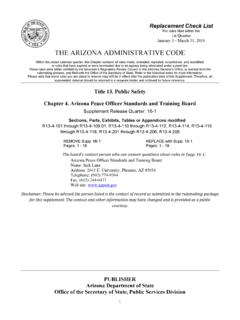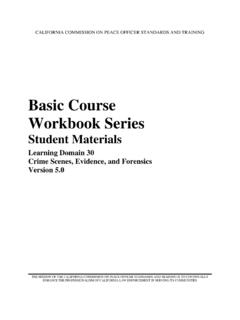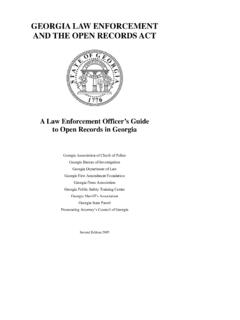Transcription of CAREER FIELD EDUCATION AND TRAINING PLAN
1 DEPARTMENT OF THE AIR FORCE CFETP 21RX Headquarters US Air Force Parts I and II Washington, DC 20330-1030 30 June 2017 AFSC 21RX LOGISTICS READINESS officer CAREER FIELD EDUCATION AND TRAINING PLAN ACCESSIBILITY: Publications and forms are available on the e-publishing website at for downloading or ordering. RELEASABILITY: There are no releasability restrictions on this publication. 1 LOGISTICS READINESS BADGE Combines the falcon, oval wreath, and globe with one lightning bolt and quartermaster key to denote the logistics readiness competencies of 1) Supply Management and 2) Deployment, Distribution, and Transportation (DDT). HERALDRY The falcon at the center symbolizes the Air Force. It also symbolizes American military strength, dedication, and devotion to duty of Logistics Readiness Officers who support the generation and employment of aerospace forces across the spectrum of warfare.
2 The globe with three encircling arrows is symbolic of the extensive range of our logistics support mission and capability to sustain our forces by land, sea, or air. The key symbolizes the security, safekeeping, and control of materiel in the old Quartermaster Corps tradition. The lightning bolt symbolizes the integrating role of contingency operations and the capability to combine essential logistics elements into a coherent plan supporting the warfighter. The olive branch surrounding the badge symbolizes the peace aerospace forces provide through a professional LRO group. Wear the basic badge after graduating from the Logistics Readiness officer Basic Course. Wear the senior badge after having completed TRAINING requirements in three of the five primary logistics readiness proficiencies of Supply, Transportation (Ground or Air), Fuels, Vehicle Management and Logistics Plans and after having completed 7-years as an LRO.
3 Additionally, the LRO must complete certification requirements for both competencies (Supply Management and DDT). Wear the master badge at the 15-year point, having completed all TRAINING requirements. NOTE: Interservice transfers that have completed another services logistics course are authorized to wear the LRO Basic Badge with documented approval from the MAJCOM A4R or 21R MAJCOM Functional Manager. 2 CAREER FIELD EDUCATION AND TRAINING PLAN LOGISTICS READINESS officer (LRO) SPECIALTY AFSC 21RX TABLE OF CONTENTS PREFACE 4 PART I Section A - General Information 6 Purpose of the CFETP CFETP Uses Coordination and Approval Section B - CAREER FIELD Description, TRAINING and Progression 7 The Logistics Readiness officer CAREER FIELD The Logistics Readiness officer and Developing the Force Implementation/Qualification Requirements Section C - Competency TRAINING Requirements 13 AFSC Prefixes 21R4 DAFSC Section D - Resource Constraints 14 PART II Section A - Course TRAINING standards 15 Task, Knowledge, and Competency Level requirements Section B - TRAINING Course Index 16 Purpose AFSC Awarding Courses Non-AFSC Awarding Courses 3 TABLE OF CONTENTS CONTINUED Section C Support Material 17 Section D - LRO Proficiency TRAINING Record 18 Charts Chart 1.
4 Logistics Readiness Competencies and Proficiencies 7 Chart 2. CAREER Progression 12 Chart 3. LOOP 19 Chart 4. LRO TRAINING Records Levels of Understanding 20 Chart 5. General Roles and Responsibilities TRAINING Matrix 20 Chart 6. Logistics Plans TRAINING Matrix 22 Chart 7. Transportation (Ground) TRAINING Matrix 27 Chart 8. Transportation (Air) TRAINING Matrix 30 Chart 9. Supply TRAINING Matrix 33 Chart 10. Vehicle Management TRAINING Matrix 41 Chart 11. Fuels TRAINING Matrix 43 Chart 12. Life Cycle Logistics TRAINING Matrix 47 Table Table 1. Qualification Requirements 11 Attachments Attachment 1: Course TRAINING standards , Logistics Readiness officer Basic Course 48 Attachment 2: Logistics Readiness officer TRAINING Courses 60 Attachment 3: Terms Explained Attachment 4: 21R Specialization Track 67 72 _____ OPR: 344 TRS/TRR Certified by: AF/A4LR, Col Jeanne I. Hardrath Supersedes: CFETP 21RX, dated 1 August 2013 Pages: 77 4 PREFACE Strategic Context: New Air Force operating concepts are evolving to meet the changing global threat requiring new logistics operating concepts to support them.
5 In turn, this will require new knowledge, skills, and abilities in our officer , enlisted, and civilian workforce that align to the way we must operate in the future. These changes must be identified and implemented across the near, mid, and long-term planning time frames. Vision: We must be able to deliberately, repeatedly, and affordably deliver high quality, integrated, agile Total Force Integration (TFI) logisticians, across all planning time horizons, with the right competencies, at the right place, at the right time to provide agile logistics support of Global Vigilance Global Reach Global Power. Air Force Logistics Human Capital Strategy, 2016 Logistics Readiness Officers, encompass the integration of logistics disciplines for air and ground transportation, supply management, fuels, vehicle management and logistics plans. Their responsibilities include directing integrated logistics processes, accomplishing joint logistics planning for warfighting support and sustainment with the joint staff, unified commands, other military services and agencies of the Office of the Secretary of Defense and directing acquisition, retail and wholesale logistics activities.
6 The CFETP: The CFETP consists of two parts that are used to plan, manage, and control TRAINING within the 21R CAREER FIELD . Officers, supervisors, and commanders will use each part to plan, manage, and execute CAREER FIELD -specific EDUCATION and TRAINING . Part I contains four sections and provides information necessary for overall management of TRAINING in the CAREER FIELD . Section A explains how to use the plan; Section B identifies CAREER progression information, duties and responsibilities, TRAINING strategies; Section C associates each skill level with qualifications (knowledge, TRAINING , EDUCATION , experience, etc.); and Section D indicates resource constraints in formal/unit TRAINING ( funds, manpower, equipment, facilities). Part II describes EDUCATION and TRAINING venues, as well as the mechanics for accomplishing required EDUCATION and TRAINING . Section A identifies Course TRAINING standards (CTSs); Section B identifies required and additional EDUCATION & TRAINING venues; Section C Support Material; Section D identifies the LRO Proficiency TRAINING Record.
7 Using the CFETP: The following individuals must utilize this CFETP to ensure LROs receive effective and appropriately-timed EDUCATION & TRAINING and skill-enhancing experience at appropriate stages in their development. At the unit level, commanders, supervisors and trainers will use Part II to plan and conduct TRAINING commensurate with the requirements directed by this plan. Additionally, individuals occupying the following positions must comply with but are not limited to the following duties and responsibilities: Individual: Individuals should complete CFETP core requirements for upgrade from 21R1 to 21R3 within 48 months of being assigned to a 21R position. Check records to ensure 21R3 certification has been awarded. With prior coordination and approval from their squadron commander (or equivalent), Air Reserve Component (ARC) members may extend this requirement to 72 months to accommodate availability constraints.
8 Individuals will also complete required EDUCATION & TRAINING requirements for upgrade to senior and master skill levels as directed by this plan. Unit TRAINING Manager: Responsibilities are outlined in AFI 36-2201, Air Force TRAINING Program CAREER FIELD EDUCATION and TRAINING . Responsibilities include (but are not limited to) loading 5 member s CFETP into TRAINING Business Area (TBA), assisting supervisors and commanders with tracking/managing completion of Competency TRAINING Matrices (Part II, Section D), and granting supervisors and commanders access to electronic TRAINING records. FIELD grade and above LROs, with at least a senior rating, do not require TRAINING records; however, the unit will ensure TRAINING is accurately identified in readiness reporting systems. Supervisor/Operations officer : Supervisors and Operations Officers will ensure trainees understand fundamentals of each Proficiency TRAINING Matrix task, manage and control officer progression through competency TRAINING , and document TRAINING completion in TBA and the Military Personnel Data System (MilPDS).
9 Supervisors and Operations Officers will also determine work center rotations, identify local TRAINING tasks and conduct documented quarterly TRAINING progress review with trainee, verify pre-task/task/post-task actions are included for follow-on TRAINING and certify completion of TRAINING . Squadron Commander: Squadron commanders (or equivalent) are responsible for ensuring assigned officers meet requirements prescribed in this CFETP. Squadron commanders (or next higher authority) will certify competency TRAINING progression by documenting task completion in TBA. These responsibilities may be delegated to the squadron Operations officer . Commanders will also certify award of the 21R3 AFSC and senior certification via submission of an AF Form 2096, Classification/On-The-Job- TRAINING Action, to their local Force Support Squadron (FSS) for final disposition. MAJCOM A4R: MAJCOM A4Rs or 21R MAJCOM Functional Manager will abide by responsibilities outlined in AFI 36-2201.
10 6 PART I SECTION A - GENERAL INFORMATION Purpose of the CFETP. This CFETP contains and provides information for CAREER FIELD functional managers, commanders, supervisors, trainers, and the technical TRAINING centers to plan, develop, manage and conduct a robust CAREER FIELD TRAINING program. This plan identifies initial skills, upgrade, qualification, advanced, and continuation TRAINING . Serves as a management tool to plan, develop, manage, and conduct a CAREER FIELD TRAINING program; it is also used to ensure established TRAINING is provided at the appropriate points throughout an officer s CAREER . Identifies requirements for each skill level and recommends TRAINING for each phase of an officer s CAREER . Lists TRAINING courses available in the specialty, identifies sources of TRAINING , and provides the TRAINING medium (See Attachment 2). CFETP uses. This is the comprehensive plan to ensure a cohesive TRAINING program is instituted for each officer .

















